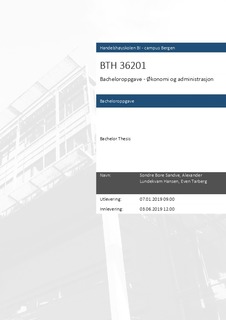Bachelor thesis
Abstract
The notion of cross-organizational collaboration has started to play a central role
in the global business world since the start of the 21st century. It is important for
organizations within business clusters to establish strong cross-boundary
networks. These networks can serve as a platform where knowledge and expertise
can easily be shared and transferred between the members. Our aim with this
research paper is to understand how organizations collaborate within cluster
communities, both by utilizing various theories and practical findings from the
real world. We have therefore decided to examine the following research
question:
“How do the members of a business cluster participate in cross-organizational
collaboration?”
The business cluster that this paper is going to analyze and study deeper is GCE
Ocean Technology – a Norwegian subsea cluster located on the West Coast of
Norway.
We will be utilizing cluster theory from Michael E. Porter (professor at Harvard
Business School) and Torger Reve (professor at BI Norwegian Business School)
to analyze our research question. We will also apply theory from various journal
articles to get a wider perspective on the topic.
Our primary data is collected using qualitative analysis, where we have utilized a
structured interview approach. This gave us the ability to have some clear preformulated
questions to ask the interviewees. Our interview sample consists of
three current cluster members – company A, company B and company C. The
interview guide is under attachments at the end of this research paper.
The results from our theoretical framework and practical findings show that there
are high levels of cross-organizational collaboration within GCE Ocean
Technology. Our discussion implies that there are several factors for participation
in cross-organizational collaboration. Some of the most important factors for our
three interviewees were organizational size (big versus small), close relationships
and organizational development opportunities and networking. They did also feel that all of the cluster members
played a significant role in creating synergy effects and that the business cluster is
a strong collective unit that can strengthen visibility and reputation on the market.
Description
Bacheloroppgave i Økonomi og administrasjon fra Handelshøyskolen BI, 2019
